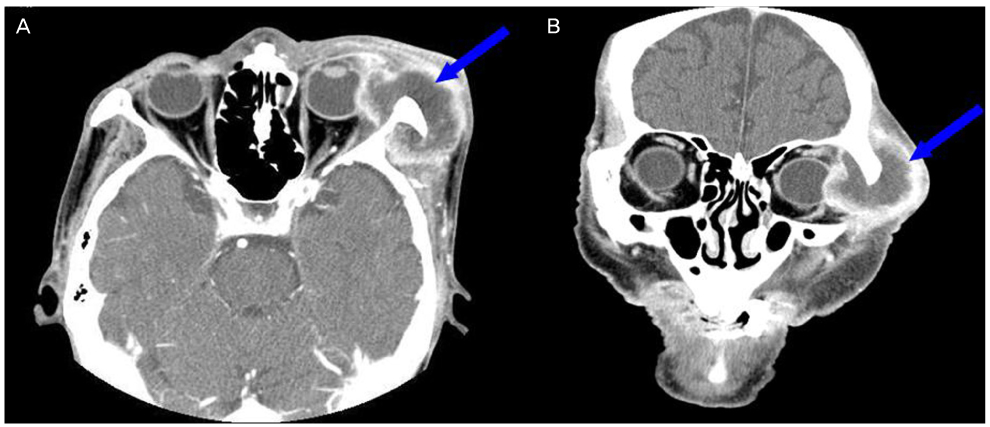Korean J Ophthalmol.
2010 Apr;24(2):123-125. 10.3341/kjo.2010.24.2.123.
Metastatic Esophageal Squamous Cell Carcinoma to the Orbit and Periorbit Masquerading as Periorbital Abscess
- Affiliations
-
- 1Department of Ophthalmology, Soonchunhyang University Cheonan Hospital, Soonchunhyang University College of Medicine, Cheonan, Korea. ophdrkim@schca.ac.kr
- KMID: 946005
- DOI: http://doi.org/10.3341/kjo.2010.24.2.123
Abstract
- A 61-year-old man with no history of malignancy presented with a rapidly expanding left periorbital mass, first noticed one month prior to presentation. The mass was firm, and a pus-like discharge drained spontaneously from the center of the lesion. A biopsy was performed, and histopathology confirmed squamous cell carcinoma. Systemic evaluation revealed that the patient had a primary esophageal squamous cell carcinoma with multiple metastases. The prognosis of orbital metastasis is generally poor, and this patient expired after one month of conservative treatment.
Keyword
MeSH Terms
Figure
Reference
-
1. Ahmad SM, Esmaeli B. Metastatic tumors of the orbit and ocular adnexa. Curr Opin Ophthalmol. 2007. 18:405–413.2. Oworu O, Kyle P, Morton R. Metastatic esophageal carcinoma presenting as a lacrimal gland tumour. Br J Ophthalmol. 2004. 88:972–973.3. Aralikatti DA, Nylander AG. Orbital metastasis from squamous cell carcinoma of the esophagus. Eur J Ophthalmol. 2006. 16:458–460.4. Collins MJ, Wojno TH, Grossniklaus HE. Metastatic esophageal carcinoma to the orbit. Am J Ophthalmol. 1999. 127:228–229.5. Tumuluri K, Sharkawi E, Bindra M, Olver JM. Esophageal adenocarcinoma metastatic to the orbit. Ophthal Plast Reconstr Surg. 2006. 22:151–152.6. Dieing A, Schulz CO, Schmid P, et al. Orbital metastases in breast cancer; report of two cases and review of the literature. J Cancer Res Clin Oncol. 2004. 130:745–748.7. Goldberg RA, Rootman J, Cline RA. Tumors metastatic to the orbit; a changing picture. Surv Ophthalmol. 1990. 35:1–24.8. Font RL, Ferry AP. Carcinoma metastatic to the eye and orbit III. A clinicopathologic study of 28 cases metastatic to the orbit. Cancer. 1976. 38:1326–1335.9. Moss HM. Expanding lesions of the orbit. A clinical study of 230 consecutive cases. Am J Ophthalmol. 1962. 54:761–770.10. Freedman MI, Folk JC. Metastatic tumors to the eye and orbit. Patient survival and clinical characteristics. Arch Ophthalmol. 1987. 105:1215–1219.11. Ferry AP, Font RL. Carcinoma metastatic to the eye and the orbit I: a clinicopathologic study of 227 cases. Arch Ophthalmol. 1974. 92:276–286.12. Char DH, Miller T, Kroll S. Orbital metastases: diagnosis and course. Br J Ophthalmol. 1997. 81:386–390.
- Full Text Links
- Actions
-
Cited
- CITED
-
- Close
- Share
- Similar articles
-
- Cutaneous Metastasis of Esophageal Squamous Cell Carcinoma Mimicking Benign Soft Tissue Tumor
- Immunotherapy for Advanced/Metastatic Esophageal Squamous Cell Carcinoma
- A Case of Metastatic Uterine Cervical Carcinma of the Orbit
- A Case of Metastatic Cutaneous Squamous Cell Carcinoma Arising in Chronic Osteomyelitic Focus
- Diagnosis and Clinical Management of Esophageal Squamous Dysplasia





